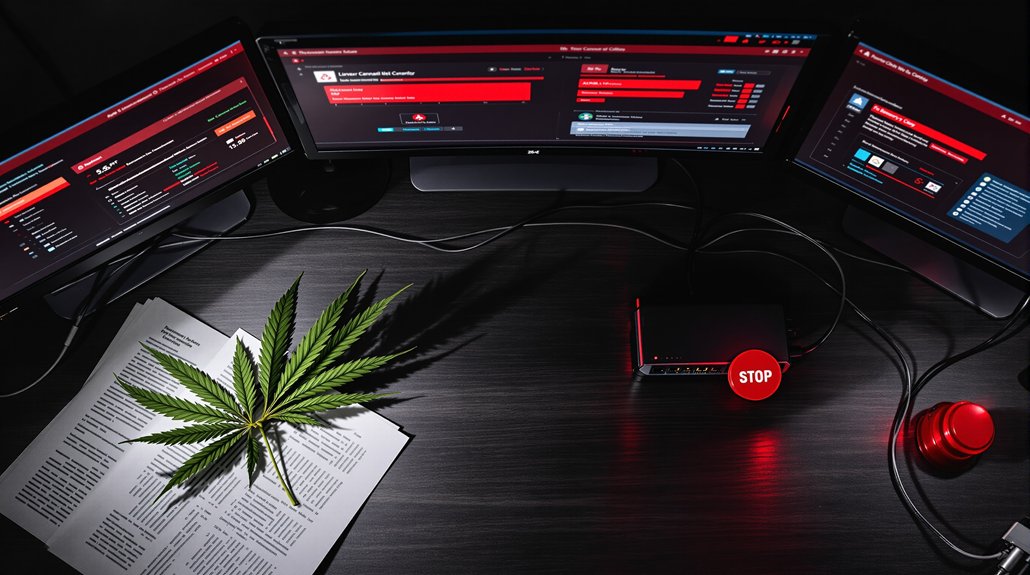Cannabis businesses face unique cybersecurity challenges that extend far beyond typical data breaches. The highly regulated nature of the industry means that a successful cyberattack can trigger cascading compliance violations, jeopardize state licensing, and disrupt critical seed-to-sale tracking systems. When hackers target cannabis operations, they often focus on valuable customer databases, financial records, and regulatory reporting systems that contain sensitive information. The aftermath requires swift, strategic action across multiple fronts to minimize damage and maintain operational legitimacy.
Immediate Response and Containment Strategies for Cannabis Businesses

When a cybersecurity incident strikes a cannabis business, the first critical hours determine whether the breach remains contained or escalates into a catastrophic operational and regulatory crisis.
Cannabis operators must immediately identify the scope of compromised systems, particularly seed-to-sale tracking platforms that maintain regulatory compliance. The initial assessment should document which customer data, financial records, or compliance information has been accessed by attackers.
Immediate assessment of compromised seed-to-sale tracking systems and breached compliance data determines the full scope of regulatory exposure.
System containment requires swift isolation of affected networks to prevent lateral movement. Businesses must disconnect compromised systems, disable breached user accounts, and shut down impacted servers while preserving digital evidence.
Network segmentation protects unaffected systems from potential spread.
Activating predefined incident response plans guarantees coordinated efforts through designated commanders.
Cannabis businesses benefit from engaging specialized consultants familiar with industry-specific regulatory requirements and unique operational challenges that traditional cybersecurity firms may overlook. Throughout the response process, operators must immediately notify relevant stakeholders, including management, employees, and state regulatory authorities to maintain compliance with cannabis industry reporting requirements. Companies should also engage third-party security experts to provide comprehensive incident analysis and recovery recommendations tailored to cannabis operations.
Legal Compliance and Stakeholder Communication Requirements
Once containment measures are in place, cannabis businesses face a complex web of legal notification requirements that demand immediate attention and precise execution.
Federal and state reporting obligations vary considerably, with strict timelines governing regulated cannabis entities. Medical dispensaries must comply with HIPAA requirements, notifying affected patients and federal authorities within 60 days of discovering patient data breaches.
Internal stakeholders, including executive leadership, IT security, legal teams, and compliance officers, require immediate notification upon breach detection.
External parties such as state cannabis regulators, law enforcement, cybersecurity insurance carriers, and affected third-party vendors must also receive timely alerts as dictated by applicable laws and contractual obligations. Organizations should implement multi-factor authentication and encryption protocols to prevent similar incidents from recurring during the recovery phase. Given that cannabis security requirements often exceed those in other regulated industries, businesses must prepare for enhanced compliance verification through potential unannounced inspections following cybersecurity incidents.
All incident communications must clearly outline the breach’s nature, compromised data types, potential impacts, and ongoing remediation efforts while avoiding speculation or proprietary investigation details.
Recovery, Enhancement, and Long-Term Prevention Measures

After containment efforts successfully limit immediate damage from a cybersecurity incident, cannabis businesses must shift their focus toward thorough recovery operations and systematic enhancement of their security infrastructure.
Recovery begins with activating established incident response plans, engaging cybersecurity experts, and preserving evidence for forensic analysis. Organizations must patch vulnerabilities, restore normal operations, and implement multi-factor authentication alongside endpoint protection software.
Long-term prevention requires extensive employee training programs focused on recognizing phishing attempts and social engineering attacks. Regular security audits, continuous monitoring systems, and backup restoration testing guarantee operational resilience. Given that cannabis companies are frequently targeted due to their high-value assets and regulatory complexity, maintaining robust defenses becomes critical for business survival.
Cannabis businesses should deploy industry-specific cybersecurity solutions tailored to their unique compliance requirements, whether operating cultivation facilities, dispensaries, or delivery services. Cyber liability insurance provides essential financial protection against the severe costs associated with data breaches, ransom payments, and legal fees. Periodic risk assessments and updated incident response plans complete the security enhancement cycle.








